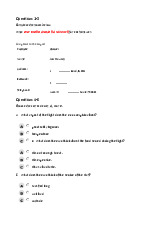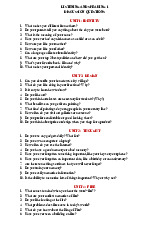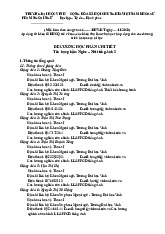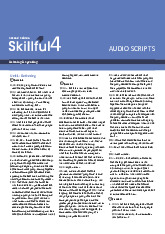







Preview text:
lOMoAR cPSD| 60701415 UNIT 3: ENERGY: DISCUSSION POINT: Discuss with a partner: 1.
I think individual factors play a significant role. Different people have different
thoughts and feelings about change. Some people think change is exciting and can
make things better, while others like things to stay the same. The way each person
thinks and feels about change can affect how they handle it. 2.
To be honest, we can use strategies effectively like clear communication,
setting realistic goals, seeking support from other and improving knowledge. For
example, when we have a dreams, we use knowledge and work to your dreams. 3.
I believe that Change managers or change coaches play a crucial role in
guiding individuals and organizations through the change process. They help to
navigate the complexities, overcome resistance, and ensure successful change
implementation. But they need to establish clear objectives at the beginning of the process. BEFOR YOU WATCH:
1. C algorithm (n) /ˈæl.ɡə.rɪ.ðəm/ thuật toán = code,
2.D binder (n) /ˈba n.dɪɚ/ chất kết dính, bìa,... material used to make things stick together
3.A constraint (n) /kən stre ntˈ ɪ / hạn chế , limitation or restriction
4.F heritage (n) /ˈher. . dɪ t̬ɪ ʒ/ di sản(belong to culture)= legacy
5.E mortar (n) /ˈm r.tɔː ɚ/ vữa , a substance used to stick bricks(gắn gạch) together
6.B vault (n) / vɑːlt / hầm , a roof in the form of an arch(vòm) 2. Watch the video:
1. F They are using techniques from the past.
2.F Architects of the past had few mechanized tools. 3. T lOMoAR cPSD| 60701415 4.T
5.F Limestone pieces have also been used. After you watch: 1.
Because with advancements in technology and construction materials,
newer and more efficient building techniques have emerged. These techniques
often offer increased speed, cost-effectiveness, and durability, leading to a shift
away from traditional methods. 2.
Because buildings were mainly designed to last and give back to sociaty as a
artistic value. These days buildings are technically better but only design to last 50 years. 3.
. I’m not a big fan of historical buildings, but I have found some architectural structures on the
internet, especially Duc Ba Cathedral in Ho Chi Minh city. I wish I were able to visit the place. 4.
I love living in a modern type of building because the architectural design is unique. Since it's
modern, it's also equipped with modern facilities which are convenient and so important in my opinion. LISTENING 1: MANAGING CHANGE A VOCABULARY PREVIEW:
1. e capability (n) /ˌke .pə b l.ə. iɪ ˈ ɪ
t̬ / , khả năng, = ability,
2. f complexity (n) /kəm plek.sə. iˈ
t̬ / sự phức tạp, difficulty,..
3.b limitation (n) /ˌ ɪl m.ə te .ˈɪ ʃən/ sự hạn chế, = restriction, constraint
4.c mode (n) /mo dʊ / cách thức =way, method, technique
5. h pursue (v) /pɚˈsuː/ theo đuổi, theo dõi, = follow, try to catch
6 d reluctant (ad) /r l k.tɪˈ ʌ ənt/ do dự, =unwilling
7.a subtle (adj) /ˈ ʌts .̬ əl/ tế nhị, tinh tế, ultra-fine, ...
8 .g transition (n) /træn z .ˈ ɪʃ ən/ chuyển tiếp,chuyển đổi, tranformation, chage 2.
1.limitations 2. Capability 3. Reluctant 4. Subtle 5. Transition 6. Complexity 7.
Pursue 8. Mode B BEFOR YOU LISTEN: C GLOBAL LISTENING:
1. The change happening at university or college lOMoAR cPSD| 60701415
2. Staff to be teaching from tablets now 2. 1. explains 2. uncertainty 3. disbelief 4. concerned 5. encourages 6. questions whether 7. accept 8. explains 9. insecurity 10. can 11. identifies 12. understand D CLOSE LISTENING:
1. A difficult meeting people stil talk about 2. very unequal
3. someone important said this at a meeting
4. quite wel -know to everybody at this meeting
5. had a memorable and relavant topic
6. the people who employed him
7. is aware they wil get training 8. met a few weeks ago E CRITICAL THINKING:
The COVID-19 pandemic has brought about a significant shift in the way people work and learn.
With the need for social distancing and the closure of schools and offices, remote work and
education have become the new norm. This change has required individuals and organizations
to adapt quickly to a new way of working and learning. STUDY SKILL:
If the talk has no structure, links, or summary, it wil be difficult to follow and frustrating to listen to. lOMoAR cPSD| 60701415
If we don't use a visual display or a handout, the audience wil have no access to the presentation plan and could become lost.
If we don't assign roles to each presenter, everyone may end up doing the same thing or we may
not cover an important role at all. -
If we don't decide who presents each point, then we risk doubling our work or leaving some points not covered.
If we don't identify how to support the person speaking, any of us could be in trouble during the
presentation without a clear way of giving help.
If we don't agree on a strategy for dealing with questions, then we risk running out of time for the
Q&A or taking questions chaotical y.
LISTENING 2 : PERSPECTIVES ON THE PAST
1. Strategic (adj) /strə ti .dˈ ːʒɪk/ chiến lược, plan...
.2. Instinct (n) /ˈɪn.st ŋktɪ/ bản năng
3. Phenomena (n) /fə n .mə.nˈ ɑː
ɑːn/ hiện tượng, happening situation, incident
4. Prone (adj) /pro nʊ / dễ bị, ảnh hưởng, at risk of (có nguy cơ) 5. Legacy (N) /ˈle .ə.siɡ / di sản, = heritage
6. Predecessor (n) /ˈpred.ə.ses.ɚ/ người tiền nhiệm, 7.Reminder (n) /r ma n.dɪˈ ɪ
ɚ/ lời nhắc nhở, promopting
8.Trigger (v) gây ra, nổ ra, to cause something to start 2.
1. I would ask my predecessors in any situation for their advice and guidance.
2. When the group I am in faces problems, my instinct is to remain calm and focused. I believe
that by keeping a level head, we can work together to find a solution that benefits everyone.
3. It is important not to surround yourself exclusively with reminders of a time in the past that is
over, as it can hinder personal growth and prevent you from fully embracing new experiences
and opportunities in the present.
4. Listening to my favorite songs from the past always triggers happy memories for me, as the
melodies and lyrics transport me back to meaningful moments and evoke positive emotions.
5. I am familiar with the phenomenon of feeling sad but happy about the past, which is often referred to as nostalgia.
6. I am prone to feeling of nostalgia when I think about my childhood. It was a simpler time, and
I often long for the carefree days of my youth.
7. I believe it is important to make strategic plans for the future. By setting clear goals and
objectives, we can work towards achieving our dreams and aspirations. lOMoAR cPSD| 60701415
8. Everyone should consider the legacy they will leave. Whether it is through our work, our
relationships, or our actions, we all have the power to make a positive impact on the world around us. B BEFORE YOU LISTEN: C GLOBAL LISTENING:
1. Scenario 1: second in order, referred to as sunk-cost fallacy
Scenario 2: third in order, referred to as legacy
Scenario 3: first in order, referred to as nostalgia 2. Order
6 We need to examine our natural desire to continue.
3 This is a natural, though often wrong, thing to do.
5 Many in the business world advise giving up on the situation.
7 Very large systems can be very difficult to change.
4 We feel we tried hard in the past and shouldn't waste this effort. or don't see the need.
9 People often don't want to change or don't see the need.
2 Music, smells, old friends, and bad moods often lead to this feeling.
8 If companies don't change, they may become less competitive. 1
This feeling creates changes in the brain.
10 The most important thing to focus on is the end result. E CRITICAL THINKING:
Of the three ideas you mentioned, it is difficult to say which one is the most harmful. However, I would say
that the sunk-cost fallacy is the most harmful. This belief can be detrimental because it leads individuals
to make decisions based on past investments rather than evaluating the current situation objectively, even
if it no longer holds value or is detrimental. It can also lead to ineffective decisionmaking, resource waste, and missed opportunities. CRITICAL THINKING: 1.
The conclusion that younger people like change more than older people do may be based
on studies or surveys that explore individuals' attitudes towards change across different age
groups. These studies could involve questions related to openness to new experiences,
wil ingness to adapt, or comfort with change. Analyzing the responses and comparing them
across age groups could provide evidence supporting this conclusion. lOMoAR cPSD| 60701415 2.
The conclusion that change can energize people and improve their performance can be
supported by research in fields such as psychology and organizational behavior. Studies have
shown that novel and challenging situations can stimulate individuals, increase their motivation,
and enhance their cognitive ability. Additionally, research on the impact of organizational change
on employee engagement and productivity can also provide evidence for this conclusion. 3.
The conclusion that organizational change costs a lot of money can be based on financial
analyses and case studies conducted in various industries. These analyses can examine the
costs associated with implementing changes such as restructuring, adopting new technologies,
or implementing new processes. By considering factors such as training expenses, potential
productivity losses during the transition period, or investments in new infrastructure, evidence can
be gathered to support the conclusion that organizational changes come with significant financial implications. VOCABULARY PREVIEW: 1.
1 Tendency (n) /ˈten.dən.si/ , xu hướng, = trend,...
2 Resilient (adj) /r z l.jəntɪˈ ɪ / lạc quan, kiên cường, = strong , hardy
3 Prevailing (adj) /pr ve .l ŋɪˈ ɪ ɪ / thịnh hành, chiếm ưu thế = be common
4. Variable (n) / ver.i.ə.bˈəl/ biến đổi, = change,
5 Outcome (n) /ˈaʊt.kʌm/ kết quả = result
6 Persist (v) / pɚˈ ɪs st / kiên trì, = go on, not give up, ..
7 Sacrifice (v) /ˈsæk.rə.fa sɪ / sự hi sinh, =
8 Initiate (v) /ɪˈ ɪʃn .i.e tɪ / khởi xướng, begin, start off 2.
1. The best way to initiate major change in a company is to start with a clear vision and a welldefined strategy.
2. Many people’s energy levels have a tendency to fluctuate when change is involved.
3. In difficult times, it is better to focus on the outcome rather than the obstacles.
4. Many people wil make a sacrifice as long as they believe it is for a greater good.
5. The prevailing view of change and development is that they are essential for growth and progress.
6. Being resilient is a useful quality when dealing with change and adversity. lOMoAR cPSD| 60701415
7. Some of the variables in any change process are the nature of the change, the people involved,
the resources available, and the external environment.
8. It is important to find energy and persist when pursuing change. SPEAKING MODEL: A ANALYZE:
1. College plans to change fees
2. Students, teachers, management
3. The cost and results of making changes to fees B DISCUSS:
1. Three possible reasons for a college to change fees are: 1.
To increase revenue: The college may be facing financial chal enges, and raising fees
could help generate more income to cover expenses and invest in infrastructure. 2.
To remain competitive: As other colleges and universities change their fee structures, this
college may need to adjust its fees to remain attractive to potential students and stay competitive
within the higher education market. 3.
To improve services: The increased fees may be used to fund upgrades and expansions
for campus facilities, academic programs, student services, and other areas that can benefit
students and enhance their college experience.
Three possible conclusions that could be drawn from a college changing their fees are: 1.
Enrollment rates may shift: If the college raises fees significantly, it could deter some
students from attending or cause current students to transfer to less expensive institutions. In
contrast, lowering fees could attract more students to the school. 2.
Student satisfaction may be impacted: Students may feel frustrated or resentful if they
perceive that the increased fees don't provide clear added value or additional benefits. On the
other hand, if the fees lead to notable improvements in campus resources and services, students
may appreciate and enjoy the changes. 3.
Financial stability may be affected: The college's decision to adjust fees could have
shortterm and long-term consequences for the institution's financial health. If the fees generate lOMoAR cPSD| 60701415
more revenue than expected, the college may have increased resources to invest in growth and
development. However, if the fees result in fewer enrollments or lower retention rates, the college
may face further financial chal enges. SPEAKING SKILLS: 1. 1. wil be picked up later F 2. wil explain more about F
3. what our previous speakers were describing B 4. as outlined by B 5. as she has already said B
6. as already highlighted by B
3. 1. El a wil talk about one of the problems... Julia will bring in the teachers ... (to organize the structure) point of view
2. Coming back to Hana's paint... (to reiterate a topic and introduce a new angle)
3. Julia wil talk more about... (to signal that the topic wil expanded later)
4. As both Hana and El a have said... (to summarize previous statements and support what comes next)
5. I'l hand this questions over to Ella... (to get support from someone who has expertise)



